Question: How much Lead and Arsenic should be allowed in crayons that toddlers might eat?
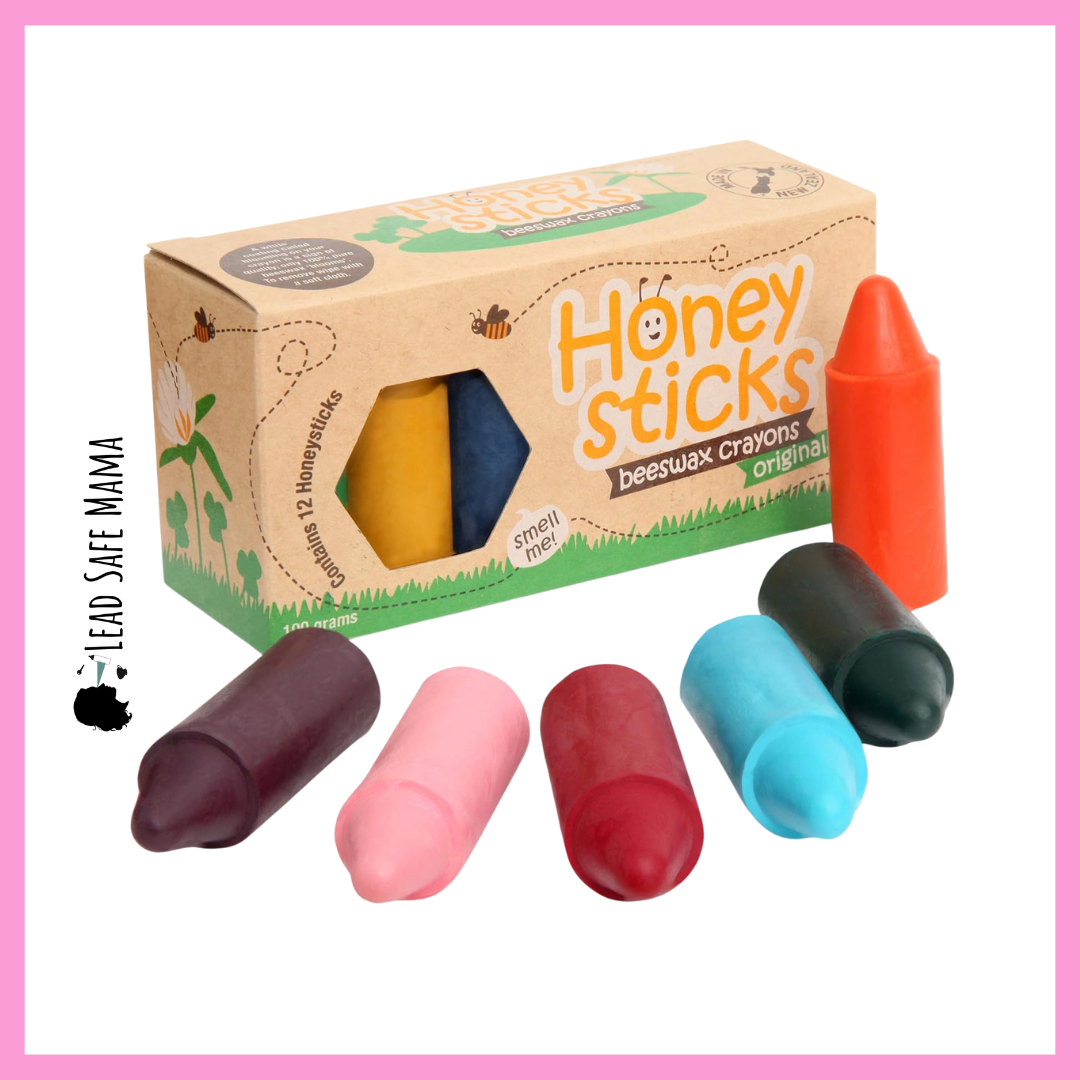
Published July 4, 2025 — Friday
A [Not-So] Quick Note from Tamara Rubin:
Two Honeysticks toddler crayons (in Pink and Red) were sent in for independent, third-party, laboratory testing through the Lead Safe Mama, LLC Community-Collaborative Laboratory Testing Initiative. The full original laboratory test reports (one for each of the two colors, as they were tested separately) can be found at the bottom of this article.
Each color crayon that we tested (red and pink) tested positive for both Lead and for Arsenic – at levels that are concerning if these crayons were to be ingested by young children.
1. Some background
- c. 2012: We discovered that there were low levels of toxicants in crayons [testing done using XRF Technology], and wrote an article about it for a previous website. We were asked to take the article down by a company – in response to the published results. This was the first time in my advocacy career that any company had asked me to take down an article — it was the first (and last) time that I caved to such a request, because I was scared of corporate retaliation; I got over that fear a long time ago ! 🙂 [that story is covered in one of the articles below].
- 2018-08/10, August: We published an article about toxicants found (using XRF technology) in Crayola Crayons – on this website -in August of 2018. Here’s the original article link.
- 2018-08/28,August: We published a follow up piece about Crayola as well.. Here’s the link to that article.
- 2018-09/02, September: We published an article about the XRF test results for Stockmar Beeswax Crayons Here’s the link to that article.
- 2019-01/02, January: Sic and a half years ago now, we published an article with full XRF test results for Honeysticks Beeswax Crayons. Here’s the link to that article.
- 2019-01/30, January: We published an article with full XRF test results for Filana Nontoxic Organic Beeswax Crayons. Here’s the link to that article.
- 2020-04/21, April: We published an article with full XRF test results for Melissa & Doug Jumbo Triangular Crayons (for ages 3+). Here’s the link to that article.
- 2020_06/2020: June: We published the XRF test results for a set of Eco-Wedge Crayons (purchased in 2019). Here’s the link to that article.
I wanted to share the above background and history with you all (the work we have already done in the area of testing crayons, and our perspective on the concern), so you would have some context regarding the test results / the levels of heavy metals found with laboratory testing of the pink and red colored Honeysticks Beeswax Toddler Crayons (purchased in May of 2025 and lab tested in June of 2025).
The full original lab reports for each of the two colors are below, at the bottom of this article — past the sharable social media graphic and past our “lab tested safer choices” list.
2. Your current lab test results are different from your XRF test results of 6-1/2 years ago. Why is that?
After reading the above-linked articles, I anticipate that some may ask “why are the current laboratory test results seemingly so different” from the results that we got testing the Honeysticks crayons using XRF technology in years past? I wanted to address this briefly as it is an important question. Below are two possible factors that might answer that question:
- Based on Lead Safe Mama, LLC’s long history of crayon testing – including investigating and reporting we have done to date specifically related to products from the Honeysticks brand (example linked above), I expect that it is quite possible that Honeysticks has been intentionally sourcing (what appears to be) cleaner colorants since we last communicated with them, given the guidance I gave them when we met in person, regarding concerns noted and suspected sources of contamination [although frankly this is pure speculation and may not be what happened to lower the toxicant levels in Honeysticks crayons at all; I have no first-hand knowledge given Honeysticks never followed up with us about the concern after our in person meeting discussing the issue ].
- For context: We met with representative from Honeysticks Crayons here at Lead Safe Mama, HQ (aka: my home office) a few years ago.
- Our XRF testing had (prior to our meeting) found the pink and red Honeysticks Beeswax crayons consistently tested positive for traces of Cadmium [which is why we chose to test those two colors now for our first laboratory testing of crayons].
- The Honeysticks representative had flown in from New Zealand and brought with him additional samples for us to test (samples of every product in their line up).
- In this meeting I explained to the representative from Honeysticks that while “food-grade” colorants might work for most foods (outside of the conversation for the concern for artificial dyes – more on that here), when integrated as a colorant into a non-food product (paint, crayons, soaps, etc.) these substances are typically used at concentrations that are MUCH HIGHER than one would find in foods.
- You need more of the food-grade colorant substance to create the same color in a non-food-based substrate.
- As an example think about how much red food-grade colorant / food dye might be need to color Jello vs.how much might be needed to color beeswax, which is much more dense than Jello).
- Specifically with crayons – to make “food-grade” colorants vibrant enough to have the resultant color (in wax) transfer to paper when they are used for drawing, a very high concentration of the colorant would need to be used.
- With highly concentrated levels of these colorants (including Zinc, and Titanium that might be used for whites, or to whiten or lighten other colors), one typically ends up with non-food-safe-level (most likely) of both the colorant ingredients and the toxicants / contaminants carried with those colorant ingredients.
- Said another way — when you concentrate a food-grade color enough to use for a non-food use purpose, you also concentrate the heavy metals and other impurities found in the ingredients of that colorant.
- You need more of the food-grade colorant substance to create the same color in a non-food-based substrate.
- We were so swamped with a backlog of testing at the time of that visit, that we never actually had time to do a follow up article after that meeting [it also was not a priority at the time, given our meeting didn’t really uncover any new information]…but I kept those crayons on my desk for all these years, as a reminder to test products from this brand when we got access to laboratory testing (which brings us to now — when we purchased new 2025 Honeysticks product , and sent that to the lab for testing).
- The second important possible consideration for why the XRF testing previously showed a concerning amount of Cadmium in the Pink and Red Honeysticks Crayons is that there could be a significant-range of batch-specific variations of toxicants in crayons, which is just one reason why this concern – the presence of toxicants in crayons that may be consumed by younger children as well a special needs kiddos with PICA – needs to be more strictly regulated so there are reasonable set limits that must not be exceeded, taking into account the ingestion concern.
3. Are there any current regulatory standards for crayons?
Are crayons regulated at all!?
Crayons are only currently regulated as “TOYS” or “art materials”, not specifically as “items that may be ingested by toddlers”.
This means that the regulatory limit (allowable level) for Lead in any crayon is measured in parts per million (ppm), not parts per billion (ppb). [There are 1,000 parts per billion in one part per million].
Heavy metals toxicity of items that may be ingested (like food) is generally measured in parts per billion, with most food toxicity levels in the range of double to triple digit parts per billion. The current FDA “guidance” for Lead in baby food (for example) is a limit of either 10 parts per billion or 20 parts per billion (depending on which guidance you look at / from what year, and which type of food it is). The FDA guidance for baby food is not an enforceable law however.
- The current regulatory limit for the paint, glaze or coating on an item intended for use by children (a toy or similar, not a food) is 90 ppm Lead.
- The regulatory limit for Lead content in the substrate of an item intended for use by children is 100 ppm Lead.
- 100 ppm Lead is the same as 100,000 ppb Lead.
- So an item could be considered safe and legal as a toy (within regulatory limits), but not safe as a food / ingested item (given the limits for toxicants in food is so much lower than the limits for toxicants in toys).
- The high level of Lead found in these two crayons tested was 208.8 parts per billion. For context, this is far in excess of the FDA current guidance of 10 ppb, or the 2021 proposed guidance of 5 ppb for items ingested by children.
- The high level of Arsenic found in these two crayons tested was 660.6 parts per billion. For context: the 2021 proposed hazard level / action level for Arsenic in items that may be ingested by children, was 10 ppb.
- Note: the guidance levels referenced above are specifically for FOOD, and we acknowledge that crayons are not food — however given the known prevalence of young children eating crayons, we are proposing that crayons should be regulated “as if” they were food, so children who might eat them are not harmed.
- There are no truly health-protective regulated total content limits for Arsenic, Cadmium, or Mercury in crayons that may be ingested by children (at least not that I am aware of, but please do let me know if you find some piece of legislation that I may not be aware of — a regulation that limits toxicants in crayons to the double or triple (max) parts per billion level, not to a level measured in parts per million).
- The levels of toxicants (specifically Lead and Arsenic) found in these Honeysticks crayons are therefore currently 100% legal and considered safe by all currently applicable regulatory standards (as they are not regulated as an item that may be ingested).
- However all relevant federal agencies agree that there is no safe level of Lead exposure for children.
4. These are legal? and “safe by all standards”?
What’s the actual problem then?
The problem lies in two areas:
- The intended user is a user that might eat the product, and
- The specific language choices (both historic and current) for the branding and marketing for this Honeysticks crayon product implies it might be safe to eat (if only eaten accidentally) – even though there is a disclaimer on the current packaging (in relatively tiny print) stating that it is not safe to eat. Details below.
- Important to Note: While I am not 100% certain, I believe this marketing language has changed in the past 6+ years. I will see if I can add some comparative images (before and after) to this article (I will look through our storage for some of the older packaging examples for this product).
To reiterate: while these pink and red Honeysticks Beeswax Toddler crayons did NOT test positive for Cadmium this time around [which we did see using XRF testing six and a half years ago], they each did test positive for concerning (but 100% LEGAL) levels of both Arsenic and Lead – concerning specifically from the perspective being that these are products sold and marketed for use by the youngest children and especially given the fact that these Honeysticks products are also sold and marketed as being a “non toxic” alternative, with “food-grade” colorants!
The bulleted list below is some of their marketing language – language that would easily convince parents not to be too alarmed if a child ate one or more of these crayons:
- Honeysticks
- 100% Pure Beeswax
- Safe for Babies and Toddlers
- For 1 Year Plus
- Made with Natural Beeswax
- Food-Grade Colors
- Eco-Friendly
- Delicious natural beeswax scent (on box, emphasis added)
- Smell me! [Notable as the product smells like a food product, especially to the intended user: Toddlers.]
The marketing language used for these toddler crayons (including the words “Delicious” scent in relatively large – and more visible – print on the package (specifically larger and more noticeable than the warning not to eat the product), and even the product name “Honeysticks” which is the name of a food product here in the United States at least), would lead parents to likely not have appropriate concern if these crayons were to be ingested by a child…however, if a parent knew the level of Arsenic and Lead in the product (and especially if their child happens to be one of those kiddos who regularly eats crayons – which is WHY the parents might choose this product in the first place – as a presumably “safe” option), they might (and should) be concerned.
The following warning language on the Honeysticks Crayons packaging is in very small thin black print against a brown background and is very easy to overlook:
“Warnings: The crayons are not for human consumption. Not to be placed in the mouth.Potential choking hazard when pieces are broken off. To be used under the direct supervision of an adult.
Here’s today’s ad listing for this product (on Amazon) showing some of their (at best, misleading) marketing language, please scroll down past the image to continue reading the article.
5. How do other crayons test compared to these crayons?
These are just the first two crayons that we have ever sent to the lab for testing, so we have no idea how Crayola and other brands might compare (beyond the preliminary testing we did years ago using XRF technology).
We have set up campaigns to help fund the cost of testing and reporting on more crayon examples, so we can review that data and compile a useful data set of lab-tested examples of current brands and colors. You can find those campaigns here — please contribute if you are in a position to do so. We would love to have some more crayons tested by the start of the 2025/2026 school year (September 2025).
- Here’s a link to the campaign to fund the testing & reporting for a pink Crayola crayon.
- Here’s a link to the campaign to fund the testing & reporting for a red Crayola crayon.
6. What should the limits of heavy metals in crayons be?
The answer to the question raised in the headline of this article: “How much Lead and Arsenic should be allowed in crayons…”, is a question that does not currently have any “offiicial” (regulated / mandated) answer. I will start by offering a first pass for your consideration as a proposed to answer this question; as a first step, I would like to suggest that crayons intended for use by younger children – a sizable number of whom routinely put them in their mouths / eat them (specifically crayons made for / marketed for use by toddlers and younger kids) – should not have levels at or above the following limits:
5 ppb Lead,
5 ppb Cadmium,
2 ppb Mercury,
and 10 ppb Arsenic.
These levels tend to be the low limits of detection for most laboratories doing this kind of testing, and so are levels that make a reasonable compromise in trying to reach the goal of “closer to zero” when considering total aggregate allowable toxicant (heavy metals) exposure for young children. If / when labs can easily consistently test to even lower thresholds of detection than those proposed above, at that time we should lower the acceptable levels to bring them even closer to zero.
7. Where is the contamination coming from in these crayons?
Given the Lead and Arsenic levels found in the pink crayon were significantly greater than the levels found in the red crayon, it would appear that the substances used to create the white part of the pigment may likely be a major/primary contributing factor to the Lead and Arsenic levels.
Our past XRF testing indicated these crayons have historically tested positive for significant levels of both Titanium and Zinc. Titanium and Zinc are used as white colorants for many other products — including in toothpastes and sunscreens — and appear to be a signficant source of heavy metal contamination for those products. Our suggestion to Honeysticks brand (in light of the lab test results for these two crayons) is that they may want to investigate their Titanium and Zinc as potential/ likely sources of the contaminants found in these crayons – and consider seeking cleaner sources for those ingredients to make their products safer for use by young children.
8. Our recommendation
Absent appropriate regulatory standards being passed for crayons, it is our recommendation that crayons should never be given to a child who may intentionally (or accidentally) bite, chew, or eat the product. We encourage others artistic play with materials dyed with actual food colorants (like beets, cabbage, etc., vs. “food-grade” colorants that may not be safe to ingest at the concentrations required to color art supplies and toys) – including homemade play dough, homemade finger paints, and other similar activities (or art activities that use actual food, so ingestion is not a concern).
Remember: All relevant federal agencies agree that there is no safe level of Lead exposure for children (and for all humans for that matter).
Please scroll down to see the full original lab report for the pink and red Honeysticks Beeswaz Crayon products.
The Lead Safe Mama, LLC Community-Collaborative Laboratory Testing Initiative is a project (started in March 2024) through which members of the greater Lead Safe Mama online community nominate products for laboratory testing and then collectively crowd-fund to cover the costs of the lab testing and reporting on nominated products. Tamara Rubin volunteers her time in support of this initiative (see our detailed budget below).
- Click through our landing page for lab reports on more products we have tested, organized by category.
- Here’s a link with our budget for testing and reporting on each product we send to the lab for testing.
- To see the original full lab report for this product, scroll down to the very bottom of the page (again, the report is below the shareable social media graphic summarizing the test results).
- Our most recently updated list of EIGHTY ONE (81) lab-tested safer choices list is below as well.
Lead Safe Mama, LLC is closed out the month of June with an operating deficit of about $7,500.00 — primarily because we sent quite a few products to the lab for testing that we did not yet raise funds for – including this Pink Honeystix Beeswax Crayon! We felt it was important (and relatively urgent) to get many of these products tested asap – as many are either products commonly consumed by young children / used by children, or sunscreen products (we have reports pending / to be published shortly for more than 40 products).
If you appreciate the work we do and would like to help keep our work going by contributing something (any amount really!) in support of covering the costs of our not-yet-funded testing and reporting, please consider making a contribution ($25? , $50? $100? — whatever you can afford) in support of the work of Lead Safe Mama, LLC through our General Fund GoFundMe or – even better – please consider joining us on Patreon with a small monthly contribution in support of the work. Thank you.
Here also are FIVE specific not-yet-funded campaigns that could use your contributions – if you are in a position to help us cover the costs of testing and reporting for any of these products:
- Primal Kitchen Organic & Unsweetened Ketchup
- Now Real Food Organic Raw Cacao Powder
- Badger Baby Sunscreen, SPF 40
- ThinkSport SPF 50 Sunscreen
- Tubby Todd SPF 50 Sunscreen For Kids
The full original lab reports for the two Honey Sticks Beeswax Crayons in Red and Pink (pictured above) can be found at the bottom of this article (below the sharable social media graphics and below our “lab-tested safer choices” list).
Again, thank you for reading and thank you for sharing this information in your communities.
The original lab reports (separate reports for each color tested) for this product are at the bottom of this article. Please scroll down.
For those new to the work of Lead Safe Mama, LLC
Tamara Rubin is a multiple-federal-award-winning independent advocate for childhood Lead poisoning prevention and consumer goods safety, and a documentary filmmaker. She is also a mother of Lead-poisoned children (two of her four sons were acutely Lead-poisoned in 2005).
- Tamara owns and runs Lead Safe Mama, LLC — a unique community collaborative woman-owned small business for childhood Lead poisoning prevention and consumer goods safety.
- Since July 2022, the work of Lead Safe Mama, LLC has been responsible for seven product recalls (FDA and CPSC).
- All test results reported on this website are science-based, accurate, and replicable.
- Please check out our press page for news coverage of our work, linked here.
This is an ad-free article.
Advertising and affiliate income help Lead Safe Mama, LLC cover the costs of the work we do here (independent consumer goods testing and childhood Lead poisoning prevention advocacy). We have removed ads from most of our more widely-read articles and new articles (like this one!) to make them easier for you to read. You can support this work by starting any shopping you might be doing by first clicking on one of our affiliate links, — you don’t need to buy what we link to for Lead Safe Mama, LLC to possibly receive a percentage of what you spend (at no extra cost to you), you simply need to click any one of our Amazon affiliate links and then go about your Amazon shopping as you normally would! Thank you for supporting our work in this way.
Are you interested in seeing MORE safer choices?
Below is an expanding list of products (foods, supplements, cosmetics, and personal care items – including sunscreens and toothpastes) that tested “non-detect” for Lead, Mercury, Cadmium, and Arsenic with independent, third-party, community-funded laboratory testing coordinated by Lead Safe Mama, LLC (an Oregon-based small business with a unique community-collaborative business model and a focus on consumer goods safety and childhood Lead poisoning prevention). The product examples below clearly demonstrate that companies can manufacture safer choices (at least from the perspective of a concern for heavy metals contamination).
–
The limits of detection (low-threshold of detection) for each of the metals tested are noted in the lab report for the specific product listed. To see the full original lab report for any of these products, type the brand name into the search bar at the top of any page on Lead Safe Mama dot com (and scroll down to the bottom of the related article). All our published lab reports are also linked here, on our lab testing landing page.
–
Flavors (or specific variations) tested are noted, and other variatons of the same product (or other products from the same brand) have either not been tested or have been tested but did not yield similar results. Test results only apply to the specific products listed and linked below.
Products on our “safer choices” list are retested periodically (annually or more frequently, as funding permits). If a product no longer tests clean, it is removed from the list.
LIST UPDATED — June 29, 2025, Sunday
Now at 75 products + 6 “bonus” options. Scroll down to see all 81 Lab-tested Safer Choices:
- Baby Food — 1 — Little Spoon Kale, Carrot + Pear BabyBlends
- Baby Food — 2 —Little Spoon Butternut Squash + Blueberry BabyBlends
- Baby Food — 3 — Little Spoon Sweet Potato BabyBlends
- Baby Food — 4 — Little Spoon Sweet Potato + Carrot BabyBlends
- Baby Food — 5 — Little Spoon Banana + Pitaya BabyBlends
- Beverage — 1 — Honest Kids Organic Appley Ever After Apple Juice Drink: https://amzn.to/4fjGhov
- Beverage — 2 — Olipop Grape Tonic: https://amzn.to/4cjFYZu
- Beverage — 3 — Synergy Golden Pineapple Kombucha: https://amzn.to/3HVzMgM
- Breakfast Cereal — 1 — Nature’s Path Envirokidz Organic Panda Puffs: https://amzn.to/4fo1crf
- Breakfast Cereal — 2 — Nature’s Path Envirokidz Organic Corn Puffs Gorilla Munch: https://amzn.to/3FHZCDO
- Candy — 1 — Cavendish & Harvey Wild Berry Drops, not organic (Made in Germany): https://amzn.to/3Z1Jxjr
- Candy — 2 — Haribo Gummy Bears (Made in Germany, not USA-produced): https://amzn.to/3FCGVlu
- Candy — 3 — Lindt White Chocolate Bar (Made in USA, New Hampshire): https://amzn.to/3OXkyIm
- Candy — 4 — Werther’s Original Butter Candies (Made in Germany, not USA-produced): https://amzn.to/4nkFc5i
- Coffee & Tea — 1 — Chameleon Handcrafted Organic Cold Brew Concentrate: https://amzn.to/3OcrH77
- Coffee & Tea — 2 —Tao of Tea Organic Genmaicha (Tamara’s favorite, from Japan, sold by a Portland, Oregon-based company!): https://amzn.to/3Dp8Fsd
- Coffee & Tea — 3 — Califia Farms Almond Latte Cold Brew (XX Espresso): https://amzn.to/4gTTGoJ
- Coffee & Tea — 4 — Death Wish Organic Espresso Roast Ground Coffee (Multi-country origin, non-USA): https://amzn.to/3yo1eiL
- Cosmetic— 1 — Babo Botanicals Sensitive Baby Lotion: https://amzn.to/3YmKxy1
- Cosmetic — 2 — Kora Organics Noni Face Oil: https://amzn.to/43hy2XO
- Cosmetic — 3 — Supergoop! Unseen Sunscreen, SPF 50 (Chemical Sunscreen, Please Read Article): https://amzn.to/3HRMVrl
- Dairy — 1 — (cheese) — Babybel Mini Original Snack Cheese: https://amzn.to/3ZY5noO
- Dairy — 2 — (coffee creamer) — Organic Valley Grassmilk Half and Half: https://amzn.to/4fHJIWT
- Fruit Snack — 1 — (bar) — Pure Organic Layered Fruit Bars in Raspberry Lemonade Flavor: https://amzn.to/3XcFsIp
- Fruit Snack — 2 — (bar) — Pure Organic Layered Fruit Bars in Strawberry Banana Flavor: https://amzn.to/3WQEekA
- Fruit Snack — 3 — (pouch) — Costco’s Kirkland Organic Apple Sauce Pouch: https://amzn.to/4gOYpZ9
- Fruit Snack — 4 — (pouch) — GoGo Squeez Organic Apple Sauce Pouch: https://amzn.to/3XhWYLe
- Fruit Snack — 5 — (pouch) — Once Upon A Farm Dairy Free Fruit Smoothie Pouch in Strawberry Banana Swirl Flavor: https://amzn.to/3CPMbAw
- Infant Formula — 1 — Bobbie Organic Gentle Infant Formula Milk-Based Powder with Iron (pink and white can): https://amzn.to/3YYb849
- Infant Formula — 2 — Bobbie Organic Infant Formula Milk-Based Powder with Iron (green and white can): https://amzn.to/3VOr4Vy
- Infant Formula — 3 — Bobbie Grass-Fed Milk-Based Powder with Iron (green can): https://amzn.to/3ZlAaeJ
- Infant Formula — 4 — ByHeart Infant Formula (USA-made, not organic): https://amzn.to/48DJjTb
- Infant Formula — 5 — HiPP Bio Combiotik Infant Formula Powder, Stage 1 (imported)
- Infant Formula — 6 — HiPP HA Stage PRE (0+ Months) Combiotic Formula (imported)
- Infant Formula — 7 — Holle Bio Goat Stage 2 Infant Formula (for 6-10 months, organic, European — Swiss/ German/ Austrian) is not available on Amazon, but the Stage 3 version of this product is (not yet tested, but will likely test similarly): https://amzn.to/3BVU7zI
- Infant Formula — 8 — Kendamil Goat Infant Formula (not organic): This product may be available at Target (it is not available on Amazon)
- Infant Formula — 9 — Kendamil Organic Follow-On Milk (European/ British Toddler Formula, for 6-12 months, Cow Milk): Not available on Amazon
- Infant Formula — 10 — Kendamil Whole Milk Infant Formula (from Europe, pink can, not organic), available at Target
- Infant Formula — 11 — Kendamil Organic Infant Formula (Cow Milk): Not available on Amazon but may be available at Target
- Ingredient — 1 — (baking flour) — Jovial Organic Einkorn Flour (Italy): https://amzn.to/3LIqxix
- Ingredient — 2 — (beans) — Jovial Organic Chickpeas, Product of Italy: https://amzn.to/4iRON1l
- Ingredient — 3 — (vinegar) — Napa Valley Naturals Organic Red Wine Vinegar (California): https://amzn.to/4jWhHOg
- Oil — 1 — (avocado) — Chosen Foods 100% Avocado Oil (not organic): https://amzn.to/3YDZSuv
- Oil — 2 — (coconut) — Dr. Bronner’s Regenerative Organic Coconut Oil: https://amzn.to/40xwBmv
- Oil — 3 — (olive) — Bryan Johnson BluePrint Snake Oil Olive Oil (not organic): https://amzn.to/4mMieUj
- Oil — 4 — (perilla seed) — Dr. Adorable’s Organic Perilla Seed Oil (Korea): https://amzn.to/3NDt7Yc
- Plant-Based Milk — 1 — (coffee creamer) — Laird Superfood Coconut Creamer: https://amzn.to/4fItA7A
- Plant-Based Milk — 2 — (plant milk) — Kiki Milk Organic Plant-Based Milk (original flavor): https://amzn.to/3AA6Qrt
- Plant-Based Milk — 3 — (soy milk) — West Soy Unflavored Unsweetened Organic Soy Milk: https://amzn.to/4dwev8l
- Salt — 1 — Jacobsen’s Sea Salt (Oregon, USA): https://amzn.to/4dcbk5L
- NEW! Salt — 2 —Maldon Sea Salt Flakes**: https://amzn.to/4iTzWTE
- NEW! Salt — 3 — Diamond Crystal Kosher Salt** : https://amzn.to/4cVQMiy
- Seeds — 1 — (chia) — Navitas Organic, Gluten-Free Chia Seeds (Mexico): https://amzn.to/3YvE7xC
- Seeds — 2 — (hemp) — Costco Kirkland Organic Hemp Seeds: https://amzn.to/4e05RP9
- Supplement — 1 — (adult) — Clean Creatine (100% Creapure), Made in Germany (use with caution, please read article): https://amzn.to/43UjrS6
- Supplement — 2 — (adult) — Doctor’s Best Vitamin C with Q-C: https://amzn.to/4hlVvea
- Supplement — 3 — (adult) — Nature’s Way Zinc Lozenges: https://amzn.to/4liDz6f
- Supplement — 4 — (adult) — Nordic Naturals Omega-3 Fish Oil: https://amzn.to/48q1j2V
- Supplement — 5 — (adult) — Pectasol Modified Citrus Pectin, Formulated in the USA: https://amzn.to/3QUmZfN
- Supplement — 6 — (adult) — Pendulum Metabolic Daily Dietary Supplement: https://amzn.to/4gY5wOm
- Supplement — 7 — (adult) — Qwell Omega-3 by The Veggie Doctor, Vegan Algae DHA + EPA + DPA: https://amzn.to/45Lbosh
- Supplement — 8 — (kids) — Baby Ddrops, Organic Vitamin D3 Supplement for Babies: https://amzn.to/49C3ktH
- Supplement — 9 — (kids) — Mary Ruth’s Organic Toddler Multivitamin Liquid Drops with Iron: https://amzn.to/3YPhcgx
- Supplement — 10 — (kids) — Mary Ruth’s Organic Toddler Elderberry Liquid Drops: https://amzn.to/42617TU
- Supplement — 11 — (kids) — Nordic Naturals Kids Vitamin D3 Gummies (Ages 3+): https://amzn.to/4l7117a
- Sweetener — 1 — (sugar) — Anthony’s Organic Granulated Cane Sugar: https://amzn.to/4jf6vLv
- Sweetener — 2— (xylitol) — Espure Organic Xylitol: https://amzn.to/3GsCSrU
- Sweetener — 3— (xylitol) — Now Real Food Granulated Xylitol: https://amzn.to/4cNWDpM
- Toothpaste — 1 — Aquafresh “FRESH & MINTY” Fluoride Toothpaste, Purchased in London, England (Made in U.K. or Slovakia) – https://amzn.to/4lhRMjO
- Toothpaste — 2 — Orajel Kids Training Toothpaste — Fluoride Free — in Natural Berry Fruity Flavor with Elmo Sesame Street packaging: https://amzn.to/41wxtrY
- Toothpaste — 3 — Miessence Fluoride-free Mint Toothpaste (AUSTRALIA): https://amzn.to/4bJc4PO
- Toothpaste — 4 — Dr. Brown’s Fluoride-free Baby Toothpaste in Strawberry Flavor: https://amzn.to/3DCehzZ
- Toothpaste — 5 — Pegciz Kids Foam Toothpaste in Watermelon Flavor, Low Flouride (packaging varies, see report): https://amzn.to/3YzP68e
- Toothpaste — 6 — Kid’s Spry Fluoride-free Tooth Gel with Xylitol in Original Flavor: https://amzn.to/41GZb4e
- Toothpaste — 7 — Essential Oxygen Fluoride-free BR Certified Organic in Peppermint Flavor: https://amzn.to/4lARZ2J
**Lab reports pending/ Not yet published as of 6/29/2025
Here’s a link to our landing page featuring all the third-party lab reports for the foods, supplements, and cosmetic products we have published to date, including those listed above. This is a good page to bookmark as it is updated several times each week, as new lab reports are published: https://tamararubin.com/lab-reports/
Stand by for more!
BONUS: Below are SIX additional products that each tested positive for trace (very low levels of) Arsenic — at levels considered safe by all standards (with the limits of detection noted in the lab report for the specific product listed).
- Infant Formula — Kendamil Goat Toddler Milk, not organic (positive for traces of Arsenic): May be available at Target or through other online retailers of European infant formulas
- Ingredient — Maseca Instant Corn Masa Flour, Product of Mexico (positive for traces of Arsenic): https://amzn.to/4iR8qWN
- Fruit Snack — That’s It Apple Cherry Bars, not organic (positive for traces of Arsenic): https://amzn.to/4fHkSWV
- Oil — Chosen Foods 100% Pure Avocado oil, organic (postive for traces of Arsenic): https://amzn.to/3BVQYQa
- Supplement — (adult) — Now Sunflower Lecithin, not organic (positive for traces of Arsenic): https://amzn.to/3AFdHzO
- Supplement — (adult) — WishGarden Immune Boost Seasonal Rescue for Pregnancy: https://amzn.to/3Cd940N
Amazon links are affiliate links.
Amazon links are affiliate links. If you purchase something after clicking on a Lead Safe Mama, LLC Amazon affiliate link, Lead Safe Mama, LLC may receive a percentage of what you spend at no extra cost to you.
Lab reports for the red & pink colors of the crayon product pictured above:
Never Miss an Important Article Again!
Join our Email List





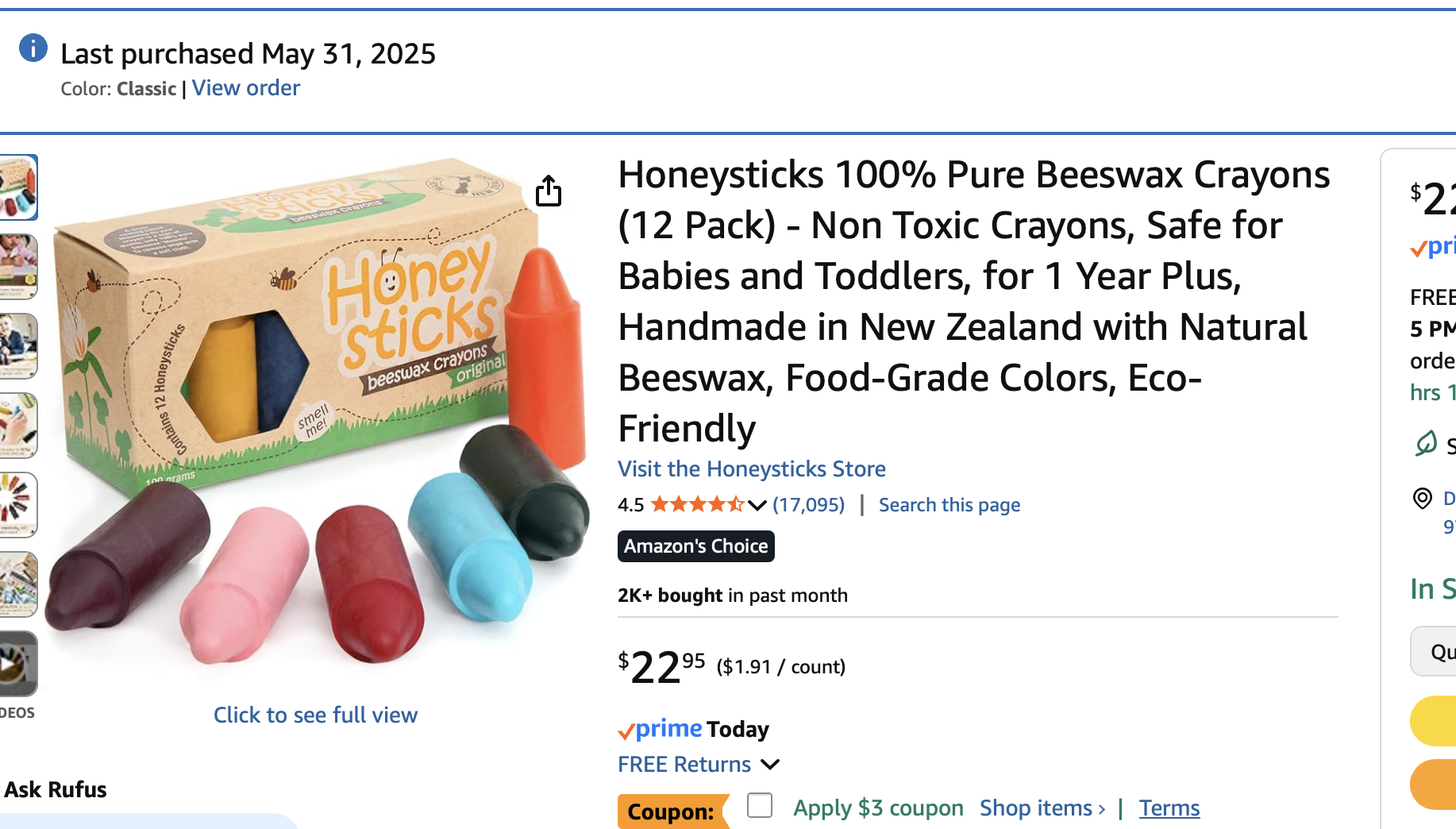
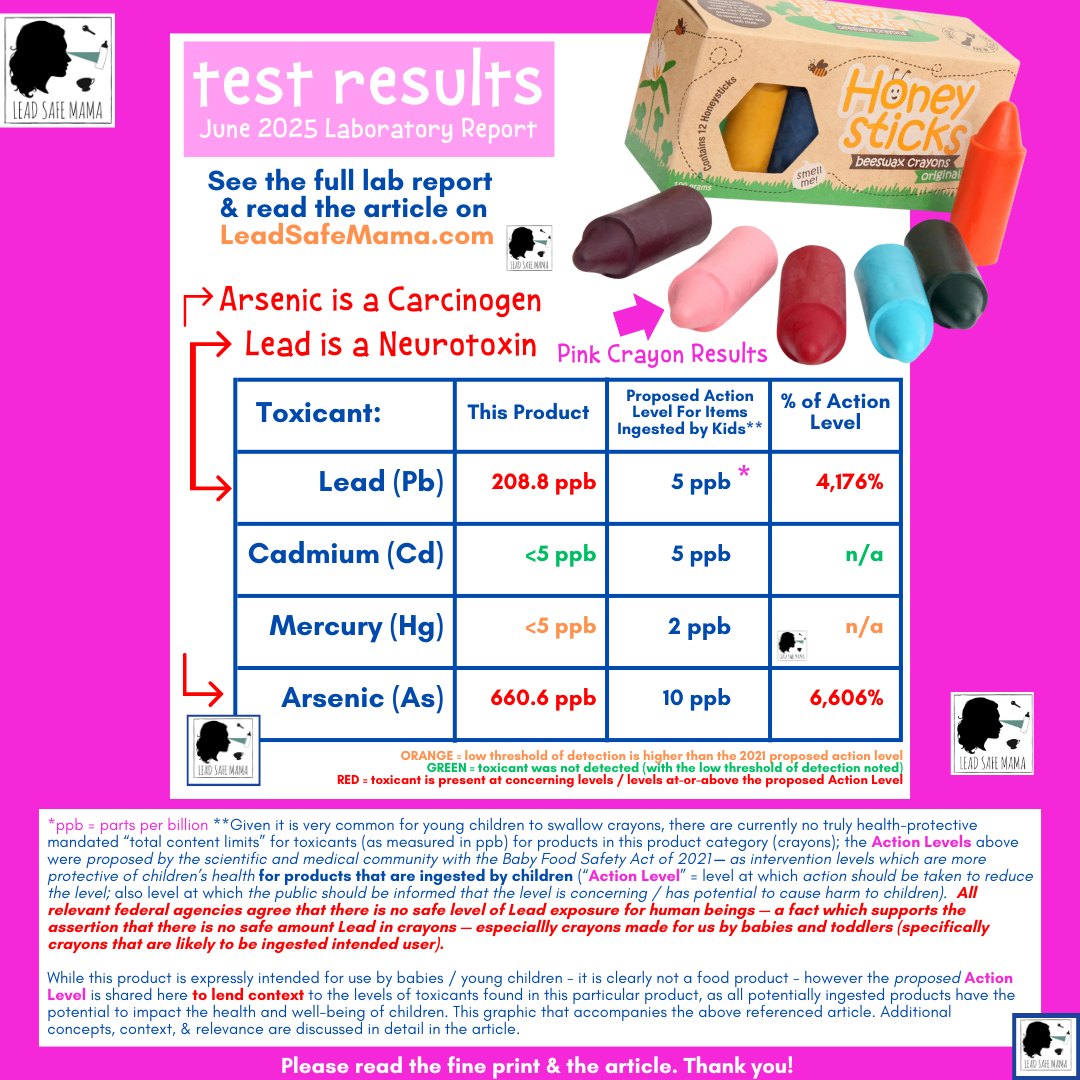
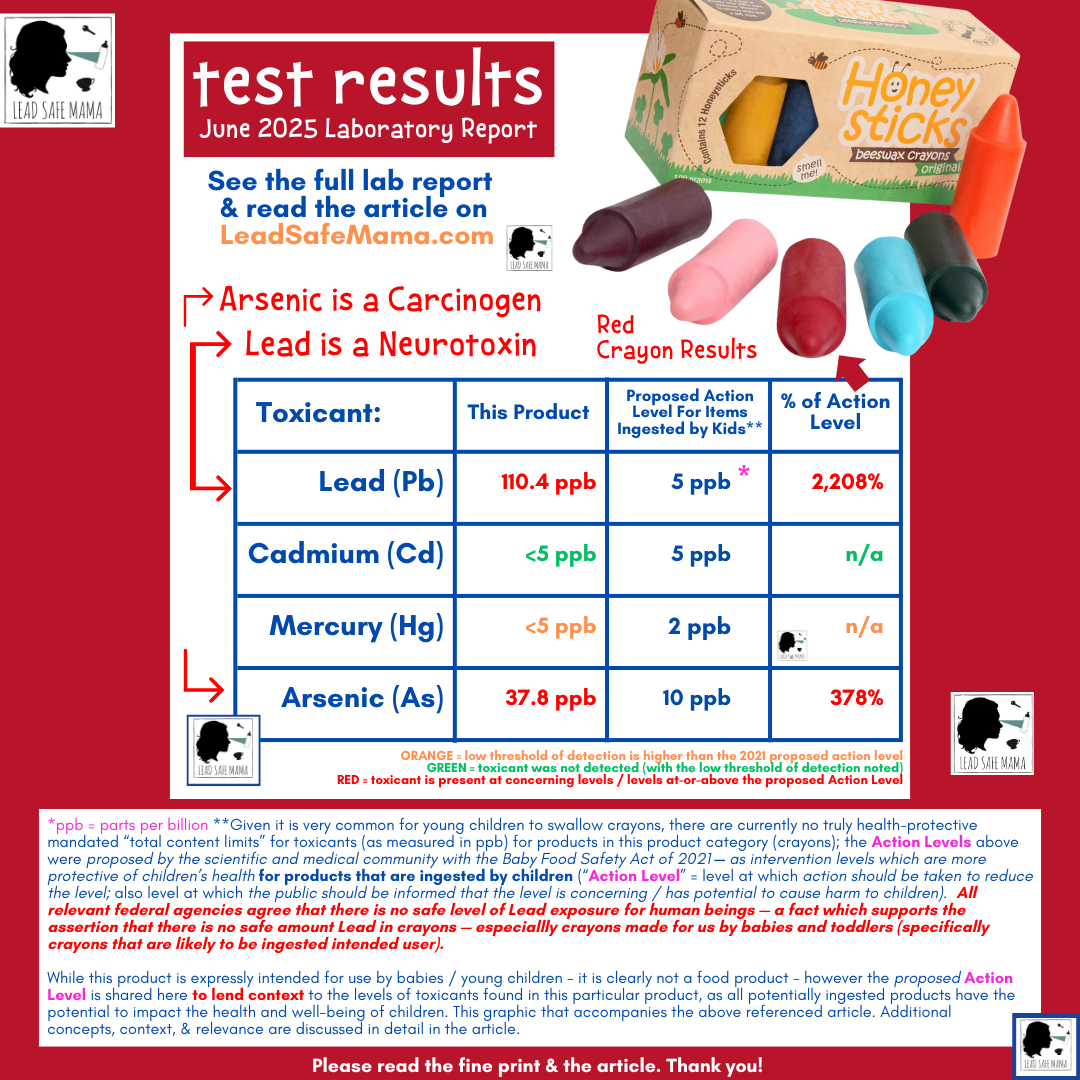
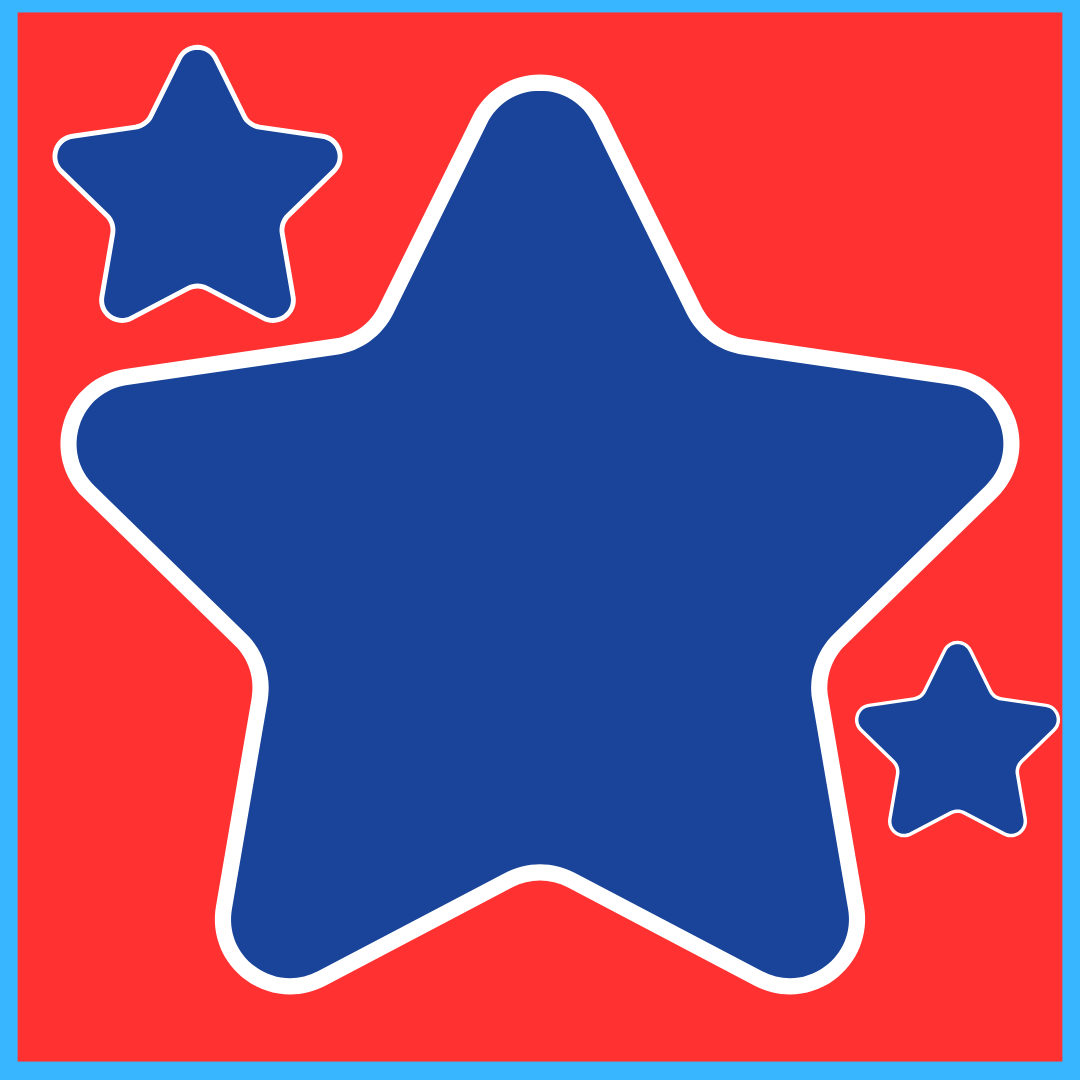
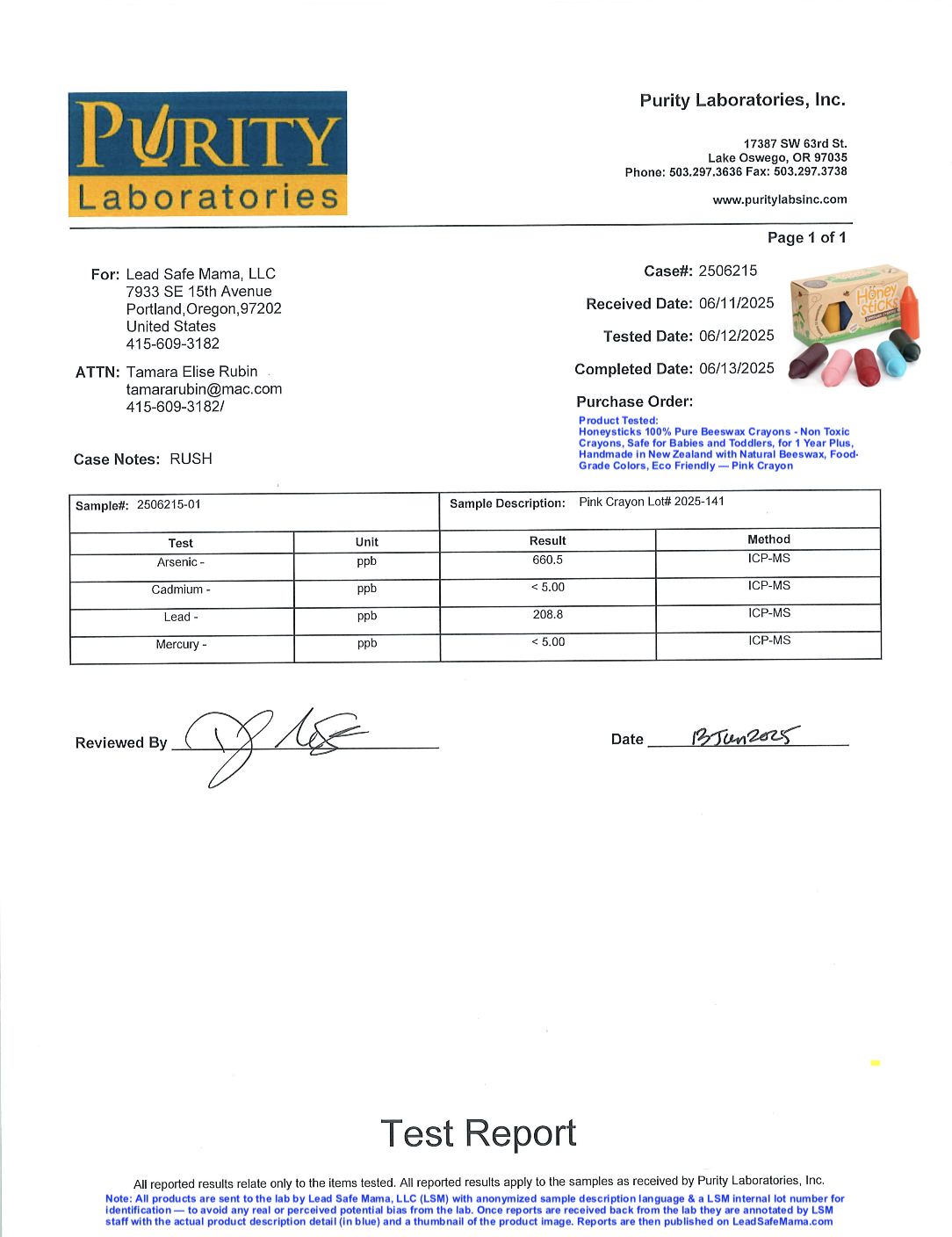
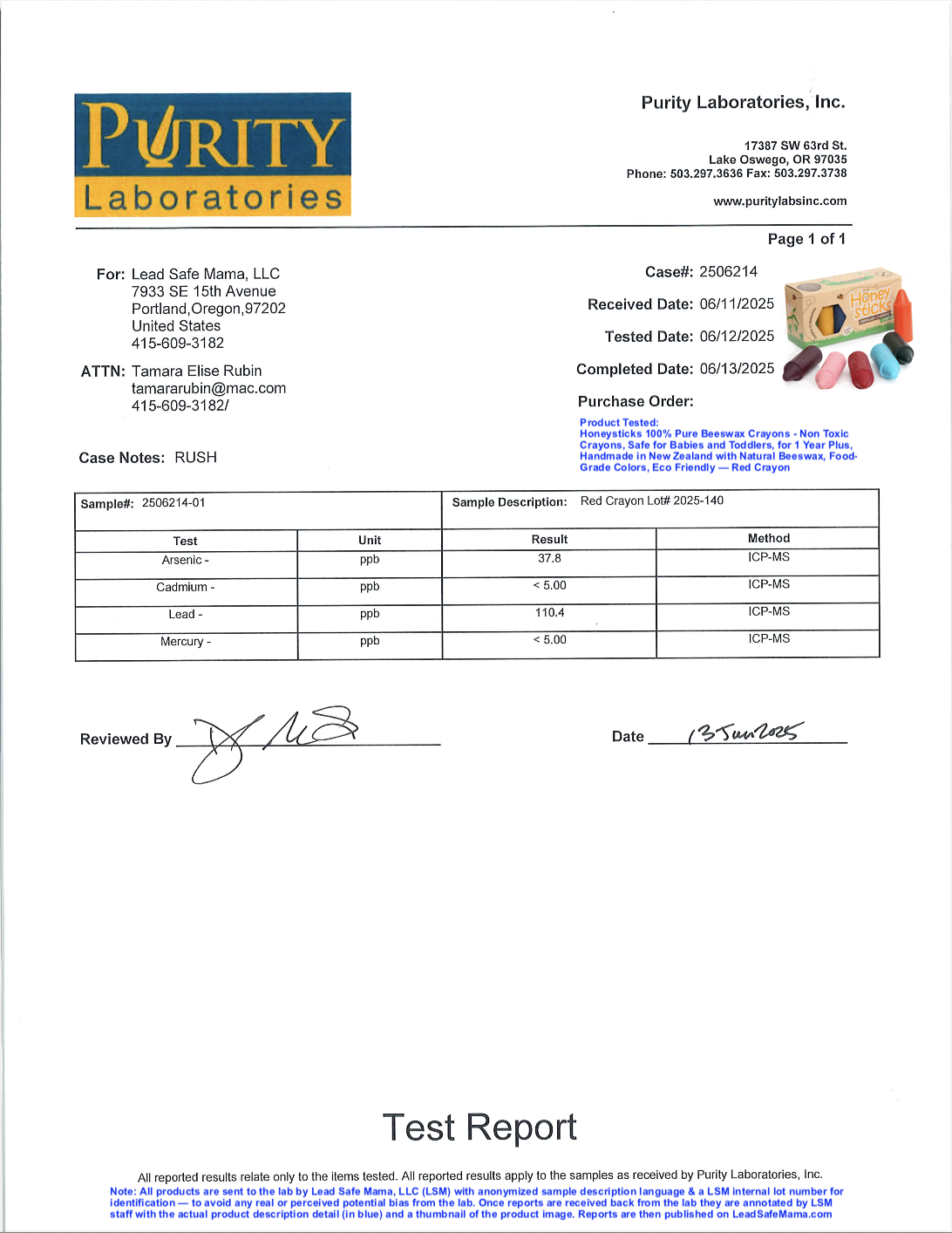

What are you suggestions for better crayon choices for toddlers? What should you do if your toddler has used these and has accidentally “chewed”/ put them in their mouth? Will there be any long term adverse effects if it was only a few times?
Per the linked articles near the top of the page, I have always recommended avoiding crayons – they are not properly regulated for use by toddlers.
If your child has not recently had a Blood Lead Level test, it is always prudent to get one – at least as a baseline.
To help you make an informed choices in the future…
Read this:
https://tamararubin.com/2024/06/when-should-babies-be-tested-for-lead-how-often-should-babies-be-tested-for-lead/
Read this:
https://tamararubin.com/2021/07/im-concerned-that-my-child-may-have-just-inhaled-potentially-leaded-fireworks-fumes-what-should-i-do/
Read this:
https://tamararubin.com/2019/02/blood-lead-testing-please-get-everyone-in-the-family-tested-since-you-have-been-living-in-a-house-with-high-lead-paint/
Read this:
https://tamararubin.com/2019/07/garlic/
And Watch our film:
https://youtu.be/lMbhbwMhs1U?si=q4C1YkwOrvhX0M7_
You might also find this helpful (especially if eating crayons has been a regular thing):
https://tamararubin.com/2017/01/symptoms/
But the film is your best resource.
Tamara
But there is no Cadmium found in both red and pink colors. Why is it marked as a concern for the red one if it is below 5?
Oops! Error! Fixed now. TY!